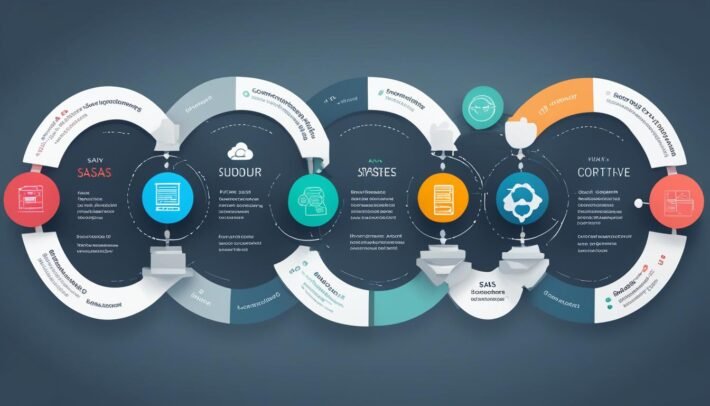Scaling Your SAAS Business: Challenges and Solutions

As a SAAS business owner, you know that growth is essential to maintaining long-term success. However, scaling your business can present a myriad of challenges, from increased demand to infrastructure limitations. It’s crucial to have a well-defined plan in place to support your business’s scalability, leveraging technology and customer-centric approaches to facilitate sustainable growth.
In this article, we will explore the importance of scaling your SAAS business, the growth challenges you may encounter, and the scalability strategies you can implement to overcome them. From developing an effective scaling plan to building a scalable team, adopting agile development practices, and expanding market reach, we will examine various facets of the scaling process in depth.
Key Takeaways
- Scaling a SAAS business is crucial for long-term success.
- Various challenges may arise when scaling, such as increased demand and infrastructure limitations.
- Implementing well-defined scalability strategies can help overcome these challenges.
- Leveraging technology and customer-centric approaches are integral to supporting sustainable growth.
- Adopting agile development practices and expanding market reach can facilitate successful scaling over the long term.
Understanding the Importance of Scaling SAAS
The success of a Software as a Service (SAAS) business hinges on scalability. As the demand for your products or services increases, it’s important to have the scalability strategies in place to ensure you can accommodate that growth. Without the ability to scale, your SAAS business risks stagnation and failure.
Scaling not only ensures you can meet demand, but it also positions your business for long-term success. When you effectively scale your SAAS business, you can expand your reach and grow your customer base, ultimately increasing revenue.
But scaling is not a one-size-fits-all solution. Every SAAS business has unique needs, and it’s important to understand the scalability strategies that will work best for your company. By developing a tailored approach to scaling, you can support sustainable growth and long-term success.
Some of the most effective scalability strategies for SAAS businesses include:
- Implementing cloud-based infrastructure
- Automating processes
- Using agile development methodologies
- Optimizing customer acquisition and retention
- Building a scalable team
By implementing these and other scalability strategies, you can ensure your SAAS business is well-positioned for growth and success.
Identifying Growth Challenges in SAAS
Scaling a SAAS business is not without its challenges. As demand increases, businesses may struggle to keep up with the pace of growth. This can manifest in various ways, such as:
- Inadequate infrastructure to handle increased traffic and user demand
- Intense competition that impedes market share growth
- Difficulty in retaining existing customers while acquiring new ones
- Insufficient investment into marketing, customer support, and R&D efforts
- Limited resources to hire and train a growing workforce
Addressing these growth challenges is key to ensuring sustainable scaling and long-term success. Businesses must develop a solid strategy to navigate these obstacles while continuing to meet the needs of their customers.

Developing an Effective Scaling Plan
Scaling a SAAS business without a well-defined plan can be risky. To ensure sustainable growth, businesses need to have a clear understanding of their goals and a roadmap for achieving them. A scaling plan should address various aspects of the business, from technology to finances to workforce.
When developing a scaling plan, it’s essential to:
- Define goals: Identify specific objectives for business growth, such as revenue targets, user acquisition rates, and product roadmap milestones.
- Assess resources and limitations: Evaluate the current infrastructure, technology, workforce, and finances to determine scalability limitations and opportunities.
- Identify growth drivers: Determine which aspects of the business are most likely to drive growth and prioritize them in the scaling plan.
- Map out an implementation strategy: Develop a detailed plan for implementing changes and monitor progress regularly to assess the effectiveness of the plan.
Strategies for implementation:
One way to approach a scaling plan is to break it down into manageable phases or sprints. This approach allows for iterative development and testing, enabling businesses to make adjustments based on feedback and insights.
“A scaling plan is a roadmap for success. Without one, businesses risk setbacks and missed opportunities.”
Another strategy is to leverage cloud-based infrastructure to scale resources up or down based on demand, reducing the risk of overprovisioning or under-resourcing. In addition, using automation and analytics tools can help streamline processes and identify areas for improvement, further supporting scalability efforts.
Leveraging Technology for Scalability
Technology plays a vital role in scaling SAAS businesses. Leveraging the right tools and platforms can help companies handle increased demand and maintain quality while expanding operations.
One of the most popular ways to use technology for scalability is through automation. Automating repetitive tasks can help reduce workload and improve efficiency, allowing teams to focus on more critical aspects of the business.
Cloud-based infrastructure is another critical technology for SAAS companies looking to scale. Using cloud services allows teams to quickly expand resources without worrying about hardware limitations. Furthermore, it can also mitigate the risk of system failure and data loss while increasing flexibility and accessibility.
Investing in a robust customer relationship management system (CRM) is another excellent way to leverage technology for growth. CRM systems can help companies gather and organize customer data, allowing teams to run targeted marketing campaigns and provide personalized customer service.
With technology evolving rapidly, SAAS companies must remain vigilant and adaptable. Staying up-to-date with technological advancements can help businesses stay ahead of the competition and achieve sustainable growth.
Optimizing Customer Acquisition and Retention
One of the main challenges associated with scaling a SAAS business is customer acquisition and retention. As demand increases, it can become challenging to attract new customers while also keeping existing ones satisfied. To overcome these growth challenges, SAAS businesses must adopt customer-centric approaches that prioritize the user experience.
One effective strategy for acquiring and retaining customers is to focus on building strong relationships through personalized interactions. By utilizing customer data and metrics, SAAS businesses can create tailored marketing and retention campaigns that resonate with individual users. Additionally, prioritizing customer support and building a scalable support system can increase customer satisfaction and retention rates.
Another key strategy for optimizing customer acquisition and retention is to prioritize product development that aligns with customer needs and preferences. Conducting user research and gathering feedback can inform product improvements and new feature development that meet the evolving needs of customers.

Ultimately, by prioritizing customer acquisition and retention through targeted marketing, personalized interactions, and product development that meets user needs, SAAS businesses can overcome the challenges associated with scaling and foster sustainable growth.
Building a Scalable Team
One of the biggest challenges when scaling a SAAS business is building a team that can support growth. To successfully scale, businesses need to hire the right people, implement processes that support scalability, and nurture a culture of growth.
First, it’s important to identify the right talent that can help drive growth. This involves defining the roles and responsibilities needed for scaling and creating job descriptions that align with those needs. Job descriptions should clearly outline the skills and experience required, as well as the company’s values and culture.
Next, businesses should implement agile processes that enable teams to work collaboratively towards shared goals. By breaking down silos and encouraging cross-functional collaboration, businesses can better adapt to changing needs and scale more efficiently.
Nurturing a culture of growth is also critical for developing a scalable team. This involves investing in employee training and development, providing opportunities for career growth and progression, and fostering a sense of ownership and accountability among team members.
“A scalable team is one that can work effectively together towards a common goal, adapting to change and scaling seamlessly as the business grows.”
Finally, utilizing technology can also help support a scalable team. Cloud-based collaboration tools, project management software, and other technologies can help streamline processes and enable teams to work more efficiently.
By implementing these strategies, businesses can build a scalable team that can support growth and adapt to changing needs. However, it’s important to continually assess and adjust the team as the business grows to ensure continued success.
Managing Financial Resources for Growth
Scaling a SAAS business can be an expensive undertaking, and managing financial resources is crucial for ensuring sustainable growth. This section explores the challenges of financing growth and provides strategies for optimizing financial resources.
Funding Options for Scaling SAAS
There are several funding options available for scaling SAAS businesses, such as venture capital, angel investors, and bootstrapping. Each option has its own advantages and disadvantages, making it important to carefully consider which option aligns with your business goals and values.
Budgeting for Growth
Creating a well-defined budget is essential for managing financial resources during the scaling process. Effective budgeting involves identifying potential costs, estimating revenue, and allocating resources in a way that supports sustainable growth.
Optimizing Financial Resources
Exploring opportunities to optimize financial resources can help SAAS businesses scale more efficiently. This may include reducing unnecessary expenses, leveraging tax incentives, and developing partnerships to share costs. By optimizing financial resources, businesses can maximize their growth potential and minimize financial risk.

“Optimizing financial resources is crucial for sustainable growth. By carefully managing expenses and maximizing revenue, SAAS businesses can scale efficiently and minimize financial risk.”
Scaling Infrastructure and Technology
Scaling a SAAS business requires a robust infrastructure and scalable technology to handle increased demands. As your user base expands and your application becomes more complex, the infrastructure must be able to handle traffic spikes and high volumes of data.
One of the most effective scalability strategies is leveraging cloud-based solutions. Cloud providers like Amazon Web Services (AWS) offer a range of resources, including computing power and storage, that can scale automatically based on your needs. This can help you avoid investing in costly hardware upfront and ensure that resources are available when you need them.
Another key approach to scaling infrastructure is optimizing systems. This involves regularly reviewing and evaluating the current infrastructure to ensure it is up to date and running efficiently. This may include upgrading hardware, implementing load balancing techniques, and streamlining processes to improve performance.
“Upgrading to the latest hardware technology can provide a significant performance boost and enhance your ability to handle larger workloads.”
| Infrastructure Optimization Strategy | Benefits |
|---|---|
| Upgrading hardware | Provides a performance boost and increases capacity to handle larger workloads |
| Implementing load balancing | Distributes workloads across multiple servers to prevent overloading |
| Streamlining processes | Reduces bottlenecks and improves performance |
By implementing these scalability strategies, SAAS businesses can ensure that their infrastructure can handle growing demands and avoid potential bottlenecks. With a robust and scalable infrastructure in place, businesses can focus on delivering high-quality products and services to their customers.
Adopting Agile Development Practices
Agile development is a methodology for software development that emphasizes flexibility and collaboration among cross-functional teams. Adopting agile development practices can help SAAS businesses support scalability by improving development efficiency, reducing time to market, and quickly adapting to customer needs.
Iterative development is a core principle of agile methodology that involves breaking down projects into small, manageable tasks, allowing teams to work on incremental changes and make adjustments as needed. Continuous integration is another key component of agile development, enabling teams to automatically test their code and catch issues early on.
Adopting agile development practices can offer numerous benefits for SAAS businesses. By prioritizing customer needs and continually improving the product, businesses can quickly adapt to changing market conditions and position themselves for long-term growth.
“Agile development has been a game-changer for our business. By breaking down complex projects into small, manageable tasks, we’ve been able to streamline our development process and quickly improve our product based on customer feedback.”
Building a Scalable Customer Support System
When scaling a SAAS business, customer support becomes an essential component of success. However, meeting the growing demands of customers can be a challenging task. It is essential to focus on building a scalable customer support system that can keep up with business growth.
One way to achieve this is by leveraging technology to automate repetitive tasks such as ticket management and knowledge base maintenance. This allows customer service representatives to focus on complex issues, providing personalized support that can enhance customer satisfaction.
Another vital component of a scalable customer support system is nurturing a culture of continuous improvement, where customer feedback is incorporated into the development process to identify areas for improvement. This will help identify and address issues before they escalate, enhancing the overall customer experience.
Providing high-quality customer support throughout the scaling process is essential for retaining existing customers and attracting new ones in the competitive SAAS market. By following these scalability strategies, businesses can build a reliable and scalable customer support system that ensures long-term success.
Monitoring and Measuring Growth Progress
When it comes to scaling a SAAS business, monitoring and measuring growth progress is crucial for success. Without proper tracking, it’s impossible to know whether your company is growing and making progress towards its goals. To effectively monitor growth, it’s essential to identify key metrics and regularly review them.
Some of the key metrics that SAAS businesses should track include:
- Monthly Recurring Revenue (MRR): This metric measures the predictable revenue that a company can expect each month, typically from subscriptions or other recurring payments.
- Customer Acquisition Cost (CAC): This metric estimates how much it costs to acquire a new customer, taking into account all sales and marketing expenses.
- Churn Rate: This metric measures the rate at which customers stop using a product or service. A high churn rate can indicate issues with customer retention or product quality.
- Lifetime Value (LTV): This metric calculates the average amount that a customer is expected to spend on a product or service over their lifetime.
In addition to tracking these metrics, SAAS businesses should also leverage analytics tools to gain deeper insights into user behavior and performance metrics. Tools like Google Analytics, Mixpanel, and Kissmetrics can provide valuable data on user engagement, retention rates, and revenue growth.
By monitoring these metrics and utilizing analytics tools, SAAS businesses can make data-driven decisions and adjust their strategies accordingly, ensuring continued growth and success.
Adapting to Change and Managing Risks
Throughout the scaling process, there will inevitably be changes and risks that arise. Successful SAAS businesses must be able to adapt to these challenges and implement effective risk management strategies to ensure sustainable growth.
One key strategy for adapting to change is maintaining a focus on the customer. As your customer base grows and evolves, it’s essential to understand their changing needs and preferences. Stay up-to-date on industry trends, gather customer feedback, and adjust your strategy accordingly.
Managing risks is another crucial aspect of scaling a SAAS business. Some common risks that arise during growth phases include cybersecurity threats, loss of key personnel, and legal issues. To mitigate these risks, it’s important to have comprehensive security protocols in place, develop contingency plans for potential staffing changes, and seek legal guidance as needed.
Overall, by prioritizing adaptability and proactive risk management, SAAS businesses can successfully scale and ensure long-term success.
Expanding Market Reach and International Scaling
Expanding market reach is a challenging but essential step towards scaling a SAAS business. This is particularly important when it comes to international scaling, where businesses need to navigate a range of cultural, linguistic, and regulatory challenges.
Growth challenges
One of the main growth challenges of expanding market reach is ensuring that your business can meet the unique needs and requirements of different markets. Cultural differences, linguistic barriers, and different regulatory environments can all impact your ability to effectively scale your SAAS business internationally.
Scalability strategies
To overcome these challenges, SAAS businesses need to develop effective scalability strategies that take into account market-specific considerations. This may involve localizing your product, adapting your marketing strategies, and building partnerships with local businesses.
Localization
Localization is a critical component of international scaling, as it involves adapting your product to meet the needs and preferences of local markets. This can include translating your software, tailoring your marketing messages, and incorporating local payment options.
Adapting marketing strategies
Effective marketing is essential when expanding market reach and scaling internationally. However, what works in one market may not work in another. As such, SAAS businesses must adapt their marketing strategies to each individual market.
Building partnerships
Building partnerships with local businesses can be an effective way to establish your presence in new markets. These partnerships can help raise awareness of your SAAS product, build credibility, and open up new opportunities for growth.
“Expanding your market reach and scaling internationally requires a deep understanding of the unique needs and requirements of each individual market. By developing effective scalability strategies and embracing localization, businesses can overcome these challenges and successfully expand their global footprint.”
Conclusion
In conclusion, scaling a SAAS business can be challenging but not impossible. By understanding the importance of scalability and the growth challenges that may arise, an effective scaling plan can be developed. Leveraging technology, optimizing customer acquisition and retention, building a scalable team, managing financial resources, scaling infrastructure, adopting agile development practices, building a scalable customer support system, monitoring and measuring growth progress, adapting to change, and managing risks are among the key strategies that can support sustainable growth.
Expanding market reach and scaling internationally may present additional challenges, but market analysis, cultural differences, and localization are among the factors that can facilitate successful expansion.
It is important to remember that scaling a SAAS business takes time and effort. By prioritizing scalability strategies, managing risks, and adapting to change, a SAAS business can achieve sustainable growth and long-term success.
FAQ
What is scaling a SAAS business?
Scaling a SAAS (Software as a Service) business refers to the process of increasing its operations, revenue, and customer base in a sustainable manner. It involves expanding the business to handle higher levels of demand and accommodate growth effectively.
Why is scaling important for SAAS businesses?
Scaling is crucial for SAAS businesses because it allows them to meet the increasing demands of customers, grow their revenue, and stay competitive in the market. It enables them to handle higher user loads, enhance their product offerings, and expand their market reach.
What are the growth challenges faced by SAAS businesses?
SAAS businesses face various growth challenges, including increased demand, limited infrastructure, competition, customer acquisition, and retention. They need to overcome these challenges to ensure sustainable growth and success in the market.
How can SAAS businesses develop an effective scaling plan?
Developing an effective scaling plan involves assessing the current state of the business, setting growth goals, identifying key metrics, implementing scalable infrastructure and processes, and continuously monitoring and adjusting the plan based on progress and market dynamics.
How can technology help in scaling a SAAS business?
Technology plays a vital role in scaling SAAS businesses. It enables automation of processes, provides scalable infrastructure through cloud-based solutions, enhances product development and deployment processes, and enables better customer experience and support.
What are the strategies for optimizing customer acquisition and retention during scaling?
Strategies for optimizing customer acquisition and retention during scaling include targeting the right audience, personalizing marketing efforts, enhancing customer onboarding and support experiences, leveraging data-driven insights, and building strong customer relationships through regular communication and value delivery.
How can SAAS businesses build a scalable team?
To build a scalable team, SAAS businesses should focus on hiring the right talent, fostering a culture of growth and learning, providing ongoing training and development opportunities, and implementing effective team communication and collaboration tools and processes.
What are the strategies for managing financial resources during the scaling process?
Strategies for managing financial resources during scaling include securing funding or investment, creating a comprehensive budget that accounts for growth initiatives, optimizing operational costs, and exploring opportunities for revenue diversification and optimization.
How can SAAS businesses scale their infrastructure and technology?
SAAS businesses can scale their infrastructure and technology by leveraging cloud-based solutions, implementing automated processes, adopting scalable architecture, optimizing server and network resources, and continuously monitoring and optimizing system performance.
What are the benefits of adopting agile development practices for scalability?
Adopting agile development practices allows SAAS businesses to embrace iterative development, continuous integration, faster time to market, flexibility in adapting to evolving customer needs and market dynamics, and better collaboration between development and other business functions.
How can SAAS businesses build a scalable customer support system?
Building a scalable customer support system involves implementing self-service options, leveraging automation in support processes, providing multichannel support, training and empowering support agents, and using analytics to identify and resolve customer issues efficiently.
What are the key metrics and strategies for monitoring growth progress in a SAAS business?
Key metrics for monitoring growth progress in a SAAS business include customer acquisition and retention rates, revenue growth, churn rate, customer lifetime value, and user engagement. Strategies include implementing analytics tools, setting growth targets, and regularly analyzing and optimizing performance based on the data.
How can SAAS businesses adapt to change and manage risks during scaling?
SAAS businesses can adapt to change and manage risks during scaling by fostering a culture of adaptability and innovation, implementing risk management strategies, regularly evaluating and adjusting growth plans, and staying informed about market trends and customer needs.
What are the challenges and strategies associated with expanding market reach and scaling internationally?
Challenges in expanding market reach and scaling internationally include cultural differences, language barriers, regulatory complexities, localization efforts, and market analysis. Strategies involve conducting thorough market research, localizing products and marketing efforts, building strategic partnerships, and having a deep understanding of customer preferences and needs in the target market.



